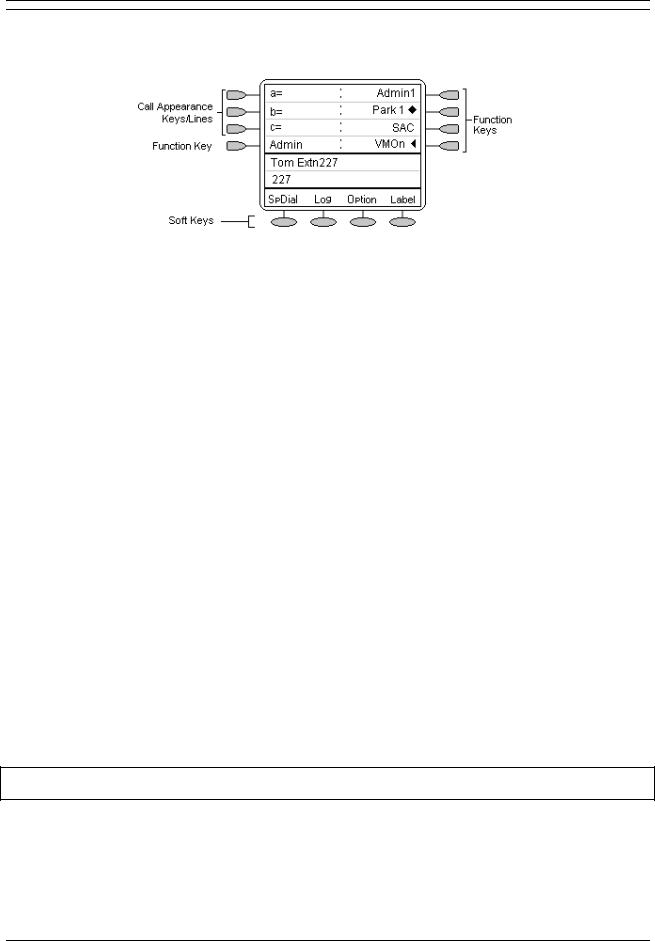Avaya 5420 User Manual

IP Office
5420/2420 Phone User Guide
Issue 6d (15th September 2005)

Table of Contents |
|
The Telephone............................................................................................................................ |
4 |
Overview..................................................................................................................................................... |
4 |
Call Appearance Keys ................................................................................................................................ |
6 |
Call Appearance Keys Icons ...................................................................................................................... |
7 |
System Features ........................................................................................................................................ |
7 |
Basic Call Handling Features.................................................................................................... |
8 |
Answer a Call ............................................................................................................................................. |
8 |
Make a Call................................................................................................................................................. |
8 |
Clearing a Call ............................................................................................................................................ |
9 |
Headset Working ........................................................................................................................................ |
9 |
Speakerphone .......................................................................................................................................... |
10 |
Speed Dial ................................................................................................................................................ |
10 |
Redial ....................................................................................................................................................... |
10 |
Mute.......................................................................................................................................................... |
11 |
Hold .......................................................................................................................................................... |
11 |
Transfer .................................................................................................................................................... |
12 |
Conference ............................................................................................................................................... |
13 |
Message ................................................................................................................................................... |
13 |
Using Speed Dials.................................................................................................................... |
14 |
Overview of Speed Dials .......................................................................................................................... |
14 |
Dialing a Speed Dial Number ................................................................................................................... |
14 |
Deleting a Speed Dial............................................................................................................................... |
15 |
Editing a Speed Dial ................................................................................................................................. |
15 |
Converting a Call Log Entry to a Speed Dial ............................................................................................ |
15 |
Adding a New Speed Dial......................................................................................................................... |
16 |
Using the Call Log ................................................................................................................... |
17 |
Overview of the Call Log .......................................................................................................................... |
17 |
Using The Call Log ................................................................................................................................... |
18 |
Viewing the Call Log................................................................................................................................. |
18 |
Making Calls from the Call Log................................................................................................................. |
18 |
Saving a Call Log Entry to Your Speed Dial List ...................................................................................... |
18 |
Deleting a Call Log Entry.......................................................................................................................... |
19 |
Erasing All Logged Calls .......................................................................................................................... |
19 |
Setting Which Calls are Logged ............................................................................................................... |
19 |
Changing Options.................................................................................................................... |
20 |
Changing Ringer Options ......................................................................................................................... |
20 |
Adjusting the Display Contrast ................................................................................................................. |
21 |
Call Log Setup .......................................................................................................................................... |
21 |
Miscellaneous........................................................................................................................................... |
21 |
Using Self Test ......................................................................................................................................... |
21 |
Selecting the Display Mode ...................................................................................................................... |
21 |
Default Phone/Erase All Settings ............................................................................................................. |
22 |
Language.................................................................................................................................................. |
22 |
Automatic Gain Control (AGC) ................................................................................................................. |
23 |
System Features ...................................................................................................................... |
24 |
System Features ...................................................................................................................................... |
24 |
Making Calls ............................................................................................................................................. |
24 |
Answering Calls........................................................................................................................................ |
24 |
Call Forwarding ........................................................................................................................................ |
25 |
Diverting Calls .......................................................................................................................................... |
25 |
Do Not Disturb .......................................................................................................................................... |
25 |
Voicemail .................................................................................................................................................. |
26 |
Default Feature Codes ............................................................................................................................. |
27 |
5420/2420 Phone User Guide |
Page ii |
IP Office |
Issue 6d (15th September 2005) |

|
Table Of Contents |
EU24 Expansion Module ......................................................................................................... |
28 |
EU24 Overview......................................................................................................................................... |
28 |
Connection ............................................................................................................................................... |
29 |
Using the EU24 Expansion Module.......................................................................................................... |
30 |
Viewing the Alternate Display .............................................................................................................. |
30 |
Selecting a Call Appearance/Feature Button....................................................................................... |
30 |
Understanding Call Appearance/Feature Button Status Icons ............................................................ |
30 |
Index.......................................................................................................................................... |
31 |
5420/2420 Phone User Guide |
Page iii |
IP Office |
Issue 6d (15th September 2005) |

The Telephone
Overview
This guide covers the use of the Avaya 5420 and 2420 phones on Avaya IP Office. Both phones are similar, however the 5420 is only supported on the IP Office whereas the 2420 is supported on a range of Avaya phone systems.
5420/2420 Phone User Guide |
Page 4 |
IP Office |
Issue 6d (15th September 2005) |

The Telephone
1.Display, Call Appearance and Feature buttons: Call Appearance Keys allow the user to handle multiple calls and the display shows call information. Details on system features (allocated by your System Administrator) can also be displayed.
2.Message lamp:Lit when the user has voicemail messages. Can also be set to flash when the phone is ringing.
3.
 Previous/Next Page: Move through the different pages of the call handling, speed dials and call log screens. Also used to move the cursor during data entry.
Previous/Next Page: Move through the different pages of the call handling, speed dials and call log screens. Also used to move the cursor during data entry.
4. Messages:Access the user's mailbox.
Messages:Access the user's mailbox.
5.Call Handling Buttons:
• Hold: Place call on hold.
Hold: Place call on hold.
• Transfer:Transfer call.
Transfer:Transfer call.
• Conference: Conference held calls.
Conference: Conference held calls.
• Drop: Drop call.
Drop: Drop call.
• Redial: Redial last number dialed.
Redial: Redial last number dialed.
6.Dial pad: Standard 12-button pad for dialing telephone numbers.
7. Volume Controls: Adjust the speaker, handset, headset, or ringer volume depending on which is currently in use.
Volume Controls: Adjust the speaker, handset, headset, or ringer volume depending on which is currently in use.
8. Mute: Turns the microphone on/off. When in use, the associated light is on and the caller cannot hear you.
Mute: Turns the microphone on/off. When in use, the associated light is on and the caller cannot hear you.
9. Headset:Switches from handset to headset. The light associated with this button turns on when the headset is active.
Headset:Switches from handset to headset. The light associated with this button turns on when the headset is active.
10. Speaker: Access the speakerphone. The light associated with this button turns on when the speakerphone is active.
Speaker: Access the speakerphone. The light associated with this button turns on when the speakerphone is active.
11. Exit: Returns you to the main call handling screen.
Exit: Returns you to the main call handling screen.
12.Softkeys:Used to navigate to or initiate certain features, such as Speed Dial or Call Log, as well as control certain actions within the features. These keys correspond to the text prompts in the display screen immediately above them.
5420/2420 Phone User Guide |
Page 5 |
IP Office |
Issue 6d (15th September 2005) |

2420user
Call Appearance Keys
Normally, the first page of the main call handling screen contains three keys set as 'call appearance' keys. These are allocated to you by your System Administrator and are indicated as a=, b= and c=.
Your System Administrator can change a call appearance key with:
•A Bridged Appearance
A bridged appearance key matches the status and operation of the Call Appearance Key on a pre-defined colleague’s telephone. Hence, you can pick-up, make and receive calls on behalf of your colleague.
•A Line Appearance
An IP Office exchange line (but not IP lines) can be allocated to you such that the status of that line is displayed and you can use the line appearance key to make and receive calls.
•Call Coverage Appearance
A call coverage appearance key alerts you when a pre-defined colleague is receiving a call. The covered user does not need to be using call appearance keys. Hence, you can pick-up calls on behalf of your colleague.
All of the above can only be allocated to you by your System Administrator.
For details of Bridged, Line and Call Coverage Appearance Keys set-up and their operation, refer the IP Office Key and Lamp Operation manual.
CAUTIONS:
1.Having more than two Call Appearance keys is very useful. When holding a call you can answer/make another call and then switch between calls or transfer or conference. If you are set to receive call waiting indication, the waiting call is shown against the next call appearance key.
2.Although the System Administrator can replace the Call Appearance Keys with:
•A Bridged Appearance
•A Line Appearance
•Call Coverage Appearance
•System Features
This would severely restrict the use of features such as conference and transfer.
It is for these reasons that it is strongly recommendedthat all Call Appearance keys remain at their default settings.
5420/2420 Phone User Guide |
Page 6 |
IP Office |
Issue 6d (15th September 2005) |

The Telephone
Call Appearance Keys Icons
The icons displayed against the Call Appearance/Feature Keys allow you to determine the status (for example, onHold) of each call. Icons also indicate whether a feature has been activated for a particular button.
•Incoming Call: 
A  symbol next to a call appearance key indicates an incoming call. Pressing the adjacent
symbol next to a call appearance key indicates an incoming call. Pressing the adjacent 
 key answers the call and puts any other current call on hold.
key answers the call and puts any other current call on hold.
•Connected:
A symbol next to a call appearance key indicates that it is the currently connected call. The
caller's telephone number (if available) is also shown. Pressing the adjacent  key puts the call on hold. AnH is also shown on the display.
key puts the call on hold. AnH is also shown on the display.
•On Hold: 
A  symbol next to a call appearance key indicates a call on hold. Pressing the adjacent
symbol next to a call appearance key indicates a call on hold. Pressing the adjacent 
 key takes the call off hold and puts any other current call on hold.
key takes the call off hold and puts any other current call on hold.
•Function Active: 

The button to the left or right of the function key is active.
System Features
System Features can only be set against soft Function Keys by your System Administrator. However, your System Administrator may allocate you two ‘self administrator’ features that will enable you to add System Features to your soft Function Keys.
In addition, there are a number of System Features thatyou can always access yourself |
by the use of |
|
short codes. Refer to System Features Introduction detailsfor |
of System Features that you can always |
|
access yourself by dialing short codes, for example *17 to listen to your voicemail messages.
5420/2420 Phone User Guide |
Page 7 |
IP Office |
Issue 6d (15th September 2005) |

Basic Call Handling Features
Answer a Call
When a call arrives at your phone, you hear a ringing tone and a blinking bell icon appears on the associated call appearance.
To answer an incoming call
Do one of the following:
•If you are not active on another call, answer the call using your handset, headset, or speakerphone (see Speakerphone).
•If you are active on a call already, place the active call on hold (Hold), and then answer the incoming call.
•If the call appearance for the ringing call is not displayed on the current screen page, use  Exit to return to the first page of the Home screen. When you locate the call appearance for the ringing call, press the corresponding call appearance button.
Exit to return to the first page of the Home screen. When you locate the call appearance for the ringing call, press the corresponding call appearance button.
Make a Call
You can make calls from the phone using a variety of methods as follows:
To manually make a call:
1.Dial the required number on the key pad (remember to include the required access code (for example, 9) for an outside line) and listen to the progress of the call.
2.Adjust speakerphone volume as necessary.
•To change the volume use the  and
and  buttons. The display shows the volume level. (There are eight volume levels.)
buttons. The display shows the volume level. (There are eight volume levels.)
3.If the call is not answered, you can clear the call by pressing  Speaker or
Speaker or  Drop
Drop
or
4. When the call is answered, either speak or pick up the handset and speak to the called party.
To automatically make a call:
Do any of the following:
•Press  Redial and a call appearance key
Redial and a call appearance key  to have the phone dial the last number that you dialed. See Redial.
to have the phone dial the last number that you dialed. See Redial.
or
•Access the Call Log and initiate a call to a specific entry. See Making Calls from the Call Log.
or
•Access the Speed Dial List in your personal directory and initiate a call to a specific entry. See Dialing a Speed Dial Number.
•When the call is answered, either speak or pick up the handset and speak to the called party.
5420/2420 Phone User Guide |
Page 8 |
IP Office |
Issue 6d (15th September 2005) |

Basic Call Handling Features
Clearing a Call
To clear an established call either:
1. Replace the handset
or
2.Press  Drop. You will hear dial tone, unless you are in ‘call center mode’ of working when you will then hear silence.
Drop. You will hear dial tone, unless you are in ‘call center mode’ of working when you will then hear silence.
Headset Working
When a headset is to be used, it must be plugged in to the headset socket on the base of the phone. To activate the headset and switch off the handset, press  Headset.The lamp beside the button is illuminated when headset working is activated.
Headset.The lamp beside the button is illuminated when headset working is activated.
To answer an incoming call:
1. Press the call appearance key  next to the flashing bell icon (
next to the flashing bell icon ( ):
):
To clear a headset call:
1. Press  Drop.
Drop.
To manually make a call:
1.Dial the number (remember to include the required access code (for example, 9) for an outside line) and listen to the progress of the call.
To automatically make a call:
Do any of the following:
•Press  Redial and a call appearance key
Redial and a call appearance key  to have the phone dial the last number that you dialed. See Redial
to have the phone dial the last number that you dialed. See Redial
or
•Access the Call Log and initiate a call to a specific entry. See Making Calls from the Call Log.
or
•Access the Speed Dial List in your personal directory and initiate a call to a specific entry. See Dialing a Speed Dial Number.
•When the call is answered, speak to the called party.
5420/2420 Phone User Guide |
Page 9 |
IP Office |
Issue 6d (15th September 2005) |

2420user
Speakerphone
The two-way built-in speakerphone allows you to make and answer calls without lifting your handset. Keep in mind that two-way speakerphones may not operate satisfactorily in every environment (such as in very noisy locations).
To make or answer a call without lifting the handset, or to use the speakerphone with any feature
1.Press  Speaker. The LED beside the button illuminates.
Speaker. The LED beside the button illuminates.
2.Make or answer the call, or access the selected feature.
3.Adjust the speakerphone volume if necessary. To change the volume use the  and
and  buttons. The display shows the volume level. (There are eight volume levels).
buttons. The display shows the volume level. (There are eight volume levels).
To change from the speakerphone to the handset (or headset if fitted)
1. Pick up the handset (or press  Headset) and talk.
Headset) and talk.
To change from the handset to the speakerphone
1.Press  Speaker.
Speaker.
2.Hang up the handset.
To end a speakerphone call
1. Press  Speaker again.
Speaker again.
Speed Dial
The Speed Dial feature allows you to have the phone automatically dial calls to telephone numbers stored in your personal directory (maximum of 104). See Dialing a Speed Dial Number.
To make a call to a personal directory entry using the Speed Dial feature
1.From the Home screen, press the  SpDial softkey. TheSpeed Dial screen is displayed.
SpDial softkey. TheSpeed Dial screen is displayed.
2.Press the button next to the entry you want to call.
3.If the entry you want is not displayed, use  and
and  to cycle through the entries or key the first letter of the required name to jump to the page with a matching entry.
to cycle through the entries or key the first letter of the required name to jump to the page with a matching entry.
4.The phone dials the number for you.
Redial
The Redial feature automatically redials a previously dialed extension or outside number (up to 24 digits). Your phone stores the last ten numbers dialed.
Note: If you have dialed the same number twice in succession, it will only have one appearance in the redial list.
To redial previously dialed number:
1.Press  Redial. Use
Redial. Use  and
and  to step through the entries. When you have located the required number, press the associated key.
to step through the entries. When you have located the required number, press the associated key.
5420/2420 Phone User Guide |
Page 10 |
IP Office |
Issue 6d (15th September 2005) |

Basic Call Handling Features
Mute
During an active call, the Mute feature prevents the party with whom you are speaking from hearing you. This feature is most commonly used in conjunction with the Speakerphone, but can be used to hold an off-line conversation at any time during a call.
Preventing the other person on the line from hearing you:
1.Press  Mute. The other party cannot hear you. The indicator next to the Mute button lights when Mute is active.
Mute. The other party cannot hear you. The indicator next to the Mute button lights when Mute is active.
2.To reinstate two-way conversation, press  Muteagain.
Muteagain.
Hold
If, with a call in progress, a second call arrives and is shown against a Call Appearance key, you can then Hold the first call and answer the second call.
To put an existing call on hold:
1. Press  Hold or the Call Appearance button with the symbol against it. The symbol changes to
Hold or the Call Appearance button with the symbol against it. The symbol changes to  ; showing that the line is on hold.
; showing that the line is on hold.
2.Answer the second call by pressing the Call Appearance button with the  symbol against it. The symbol changes to ; showing that the line is connected.
symbol against it. The symbol changes to ; showing that the line is connected.
To return to the held call:
1.If you have a call in progress, then first put that call on hold as above.
2.To retrieve a held call, simply press the Call Appearance button with the  against it.
against it.
Note: After a pre-set time (defined by your System Administrator), you are reminded that you have a call on hold by the  hold icon changing for a few moments to
hold icon changing for a few moments to  and the phone ringing.
and the phone ringing.
5420/2420 Phone User Guide |
Page 11 |
IP Office |
Issue 6d (15th September 2005) |
